ISSN ONLINE(2278-8875) PRINT (2320-3765)
ISSN ONLINE(2278-8875) PRINT (2320-3765)
S.Ravivarman1, T.Samydurai2
|
| Related article at Pubmed, Scholar Google |
Visit for more related articles at International Journal of Advanced Research in Electrical, Electronics and Instrumentation Engineering
This paper presents modern single switch dc to dc converter modelling and control of a grid connected renewable energy. The system consists of a Photo voltaic cells, a SEPIC DC-DC converter used for Maximum Power Point Tracking (MPPT), a three-phase grid converter. A nonlinear control performance of a three-phase inverter is proposed to recompense unstable load currents. It permits whole control of DC bus voltage, while calculating power flow from the PV cells to the system and guarantying objective sinusoidal grid currents at unity Power factor under varying solar irradiation. Moreover, a sliding mode control system for a SEPIC DC-DC converter is used to extract the MPPT. The proposed control techniques have exposed good performance. The system is validated using the "Power system Block set" simulator under different values of the solar irradiation.
Keywords |
| Solar array, MPPT, SEPIC converter, Three level inverter, utility GRID. |
I.INTRODUCTION |
| Energy from Photovoltaic source has been considered green energy as it does not pollute the environment and also it is renewable. Hence energy from PV source is considered to be an important source of energy among various renewable sources of energy. Now-a-days due to the advancement of technology in the field of manufacturing of PV cells the efficiency has been increased to such a level that the application of PV cells in power systems becomes a feasible one. In the recent period injecting the power obtained from the PV sources into to the grid becomes more popular as it is feasible to inject both active and reactive power into the grid thereby aiding the Electric Power network. Invariably whether the PV system is grid connected or standalone or hybrid system extraction of maximum possible power at a particular level of irradiation is very important as it increases the utility of the PV cells. Many methods or techniques have been proposed so far to improve the utility of the PV cells and such methods or techniques are called as Maximum Power Point Tracking (MPPT) [1], [2], [3] techniques.A new class of single-switch non-isolated dc-dc converters with high-voltage gain and reduced semiconductor voltage stress is described. This topologies utilize a voltage multiplier cell and/or hybrid switched-capacitor technique for providing high voltage gain without extreme switch dutycycle[ 9],[13]. The voltage-based technique is widely used because of its inherent stability withrespect to the irradiance variation due to the logarithmic dependence of the PV voltage with respect to the irradiance level. The current-based technique, instead, takes advantage of the linear dependence of the PV current on the irradiance level[10][11]. In most of the grid connected PV systems, the configuration consists of two stages such as a DC-DC converter in the front end to track the maximum power point at all possible atmospheric conditions and an inverter at the back end feeding the power extracted from the PV source by the front end converter into the grid. In the presented paper, a method has been proposed consisting of two stages, having a SEPIC converter at the front end and a three phase inverter at the back end, thereby maximum possible power extracted from the PV modules is injected into the power grid. |
II. MATHEMATICAL MODEL OF A PV MODULE |
| Basically a PV module consists of many PV cells arranged in series as well as in parallel to meet the terminal requirements such as nominal operating voltage and current in order to meet out the desired power output. Now-a-days large modules with many cells, all connected in series, are quite obvious. |
 Figure 1: Equivalent Circuit model of a PV module having NS Cells in Series |
| The electric circuit model of such a PV module shall be represented by, an ideal current source supplying power in relation to the incident solar radiation, a diode representing the PN junction in the PV cells, a lumped resistance representing the leakage effects, all connected in parallel and one more resistance representing the various effects along the direction of flow of PV current, connected in series with the previously mentioned parallel combination, is shown in the figure (1) [4]. The ivbehaviour of such a PV module described as above can be appropriately modeled analytically and can be represented by a characteristic equation [5] as given in equation (1). |
 (1) (1) |
| where |
| V Output Voltage of PV Panel |
| I Output Current of PV Panel |
| Ip Light Generated Current |
| IOS Reverse Saturation Current |
| VT Volts Equivalent temperature |
| Generally the magnitude of Rsh is large enough [9], [10] such that almost for all practical applications the term appears last in equation (1) can be neglected, and can be reduced to equation (2). |
 (2) (2) |
| Under open circuit condition, whereupon the terminal current of the PV module is virtually zero, the equation (2), representing the I-V behaviour of the PV module shall provide the open circuit voltage ‘Voc’ of the PV module as given by equation (3), |
 |
 |
 |
| This is the rudimentary idea behind the incremental conductance technique. Normally the equality rarely occurs [8] therefore a small error factor is incorporated to satisfy the condition. |
| MPPT Controller |
| Maximum power point tracking checked by incremental conductance method + Integral regulator. |
| Maximum power point is obtained when dP/dV=0 where P= V*I |
| d(V*I)/dV = I + V*dI/dV = 0 |
| dI/dV = -I/V |
| The integral regulator minimizes the error (dI/dV + I/V) |
| Regulator output = Duty cycle correction |
| SEPIC CONVERTER |
| The purpose is situated to design and optimize a SEPIC dc/dc converter (Single Ended Primary Inductance Converter). The SEPIC converter allows a range of dc voltage to be adjusted to maintain a constant voltage output. This job talks about the importance of dc-dc converters and why SEPIC converters are used instead of other dc-dc converters. This undertaking also goes into detail about how to control the output of the converter with either a potentiometer or feedback to show how it can be implemented in a circuit. From this project, one learns dc-dc converter optimization and control.Circuits run best with a steady and specific input. Controlling the input to specific sub-circuits is crucial for fulfilling design requirements. AC-AC conversion can be easily done with a transformer; however dc-dc conversion is not as simple. Diodes and voltage bridges are useful for reducing voltage by a set amount, but can be inefficient. Voltage regulators can be used to provide a reference voltage. Additionally, battery voltage decreases as batteries discharge which can cause many problems if there is no voltage control. The most efficient method of regulating voltage through a circuit is with a dc-dc converter. There are five main types of dc-dc converters. Buck converters can only reduce voltage, boost converters can only increase voltage, and buck-boost, Cuk, and SEPIC converters can increase or decrease the voltage. |
| Some applications of converters only need to buck or boost the voltage and can simply use the corresponding converters. However, sometimes the desired output voltage will be in the range of input voltage. When this is the case, it is usually best to use a converter that can decrease or increase the voltage. Buck-boost converters can be cheaper because they only require a single inductor and a capacitor. However, these converters suffer from a high amount of input current ripple. This ripple can create harmonics; in many applications these harmonics necessitate using a large capacitor or an LC filter. This often makes the buck-boost expensive or inefficient .Another issue that can complicate the usage of buck-boost converters is the fact that they invert the voltage. Cuk converters solve both of these problems by using an extra capacitor and inductor. However, both Cuk and buck-boost converter operation cause large amounts of electrical stress on the components, this can result in device failure or overheating. SEPIC converters solve both of these problems |
| Operation |
| All dc-dc converters operate by rapidly turning on and off a MOSFET/IGBT, generally with a high frequency pulse. What the converter does as a result of this is what makes the SEPIC converter superior. For the SEPIC, when the pulse is high/the IGBT is on, inductor 1 is charged by the input voltage and inductor 2 is charged by capacitor 1. The diode is off and the output is maintained by capacitor 2. When the pulse is low/the IGBTis off, the inductors output through the diode to the load and the capacitors are charged. The greater the percentage of time (duty cycle) the pulse is low. This is because the longer the inductors charge, however, if the pulse lasts too long, the capacitors will not be able to charge and the converter will fail as shown in Fig .2. |
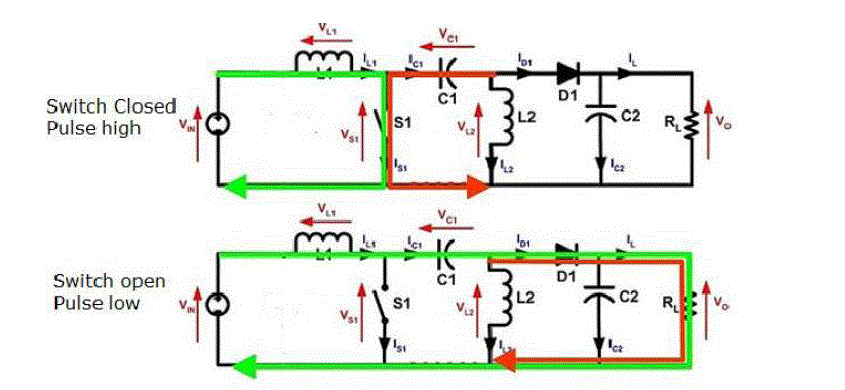 Figure 2: SEPICConverter operation |
| Three Phase Voltage Source Inverters |
| Inverters are commonly used for medium voltage applications. For high-voltage high-power applications, the inverter also serves as a control mechanism for the reactive power and voltage stabilization. With the multilevel converter topology the output waveform can be formed with smaller voltage steps (dv/ dt), which also decreases the stress on the bearings and windingisolation. It obviously also gives a lower total harmonic distortion (THD) in the output, because of the closer resemblance to the sinusoidal waveform. For multilevel converters, medium voltage semiconductors devices can still be utilized for high-voltage high-power applications. Still standing is the issue with the capacitor voltage balancing problems. However, still the multilevel converter dominates on the power electronic platform. |
| The most studied and tested multilevel types are: |
| Cascaded H-Bridge Multilevel Converters |
| Flying Capacitor Multilevel Converters |
| Diode Clamped Multilevel Converters |
| For this sector mainly the diode clamped converter will be discussed and studied. The mind behind the inverters switching combination is the pulse width modulation (PWM). There are several different modulation strategies to approach. One of these is the Space Vector Pulse Width Modulation (SVPWM) and will be the theoretical base of this proposition. |
| Diode Clamped Multilevel Converters |
| The diode clamped multilevel inverter has almost the same structure as the flying capacitor, but Instead of capacitors this inverter type uses diodes as clamping devices, creating the desired output voltage. The voltage across each capacitor is defined as V DC /(m−1) , mbeing the number of levels and (m−1) the amount of capacitors needed. So, for a two-level inverter the voltage is VDC and for that case one capacitor is used. For a three-level inverter the voltage is VDC/2 and therefore is in need of two capacitors. This specific design makes it possible to increase the number of levels just by increasing the amount of capacitors. In this context the terminology “neutral point clamped” is often used. It describes the neutral point between two capacitors connected across the DC-bus adding an extra level to the system. If m is an even number, the neutral point is not utilized, so then it is usually called a multiple point clamped converter. Experience show that higher levels than the three-level converter cause voltage balancing problems, so it is common to use the three level inverter, but there are studies demonstrating SVPWMs with self-balancing systems. |
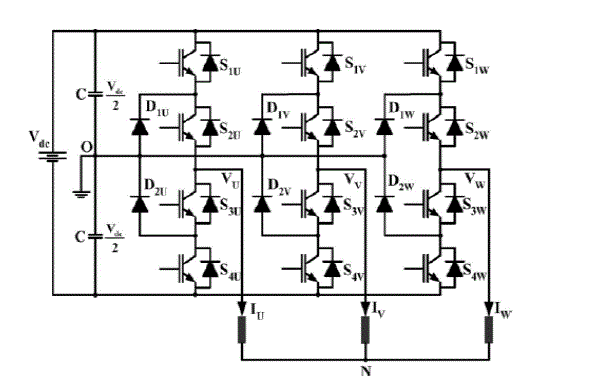 Figure 3: Three level Diode clamped (neutral point) clamped inverter |
| Fig.3 shows athree-level inverter needs in a three-phase system 6 diodes. These higher level inverters may work in theory but not in practice. The two diodes clamps the switching voltage to half of the DC-bus voltage and the difference between Va0 (for an example when S1 and S2 is on, the voltage across aand 0 is VDC, giving Va0 = VDC) and Van gives the voltage across one capacitor (VDC/2). It is important to add that the upper and lower switching pairs are complementary.To design a space vector modulated three-level neutral-point diode-clamped converter that can suit any high power application such as the renewable power generation. Mainly because renewable power resources are unreliable and lacks the form of an even output, regulation and adaptation is needed. |
III. PROPOSED METHOD OF POWER EXTRACTION AND GRID INJECTION |
| In the proposed method of power extraction from the PV module a SEPIC converter is used which also supplies power as input to the next stage consists of a three phase inverter. The inverter is operated in such a way that the power extracted from the PV module is injected into the grid, also at the same time the level of harmonics, the reactive power compensation and the current balancing are taken care of. The block diagram of the proposed configuration is shown in figure (2). In order to extract the maximum possible power from the PV module, a popular existing MPPT technique of Incremental conductance technique [6], [7] is incorporated in the proposed configuration. These dc-dc converters are regulated by the conventional PWM method at constant frequency. The converters container achieve large stair up conversions ratio, without a transformer and also continue low voltage stress across all semiconductors[11], The procedure for scheming a sliding mode controller for maximum power point tracking photovoltaic (PV) applications. It is applied to a single-ended primary inductor converter, therefore to a fourth-order topology, but it can be comprehensive to a widespread class of converters suitable for PV uses [12], [13]. The focus of this paper is on the three-phase inverter interfacing the renewable energy sources to the local bus of the micro grid in the presence of local loads as highlighted in the following diagramFig 4. |
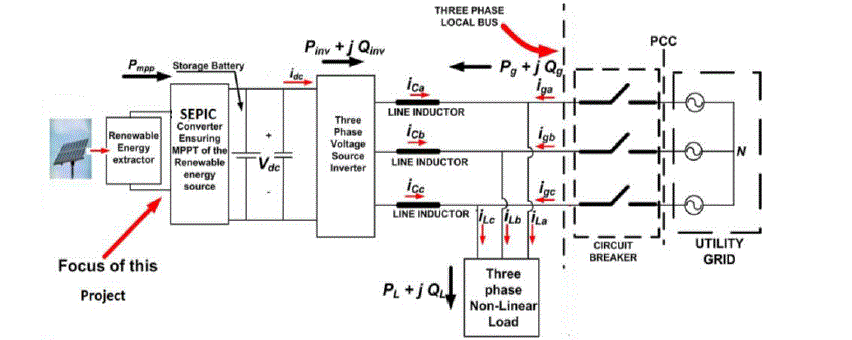 Figure 4: Typical configuration of a renewable-energy-fed three-phase grid. |
IV. SIMULATION OF GRID TIE- UP INVERTERUSING SEPIC CONVERTER |
| The complete simulation was carried out using the software Sim-Power system tool box of MATLAB. SimPower Systems software and other products of the Physical Modelling product family work together with Simulink software to model electrical, mechanical, and control systems. SimPower Systems extends Simulink with tools for modelling and simulating the generation, transmission, distribution, and utilization of electrical energy. It provide models of a lot of method used in these systems, together with three-phase machines, electric drives, and libraries of application-specific models such as wind-power generation. The single switch high gain dc/dc converter for alternative energy sources MATLAB/Simulink block diagram shows in fig 5.The renewable solar energy gives some potential energy to SEPIC converter, It has high gain output gives to the three level diode clamped three phase inverter and it connected to gird through synchronizing transformer. The output from the PV Module corresponding to the solar irradiation level depicted above is shown in fig (4). The figure clearly illustrates the dependence of PV performance over the level of irradiation. |
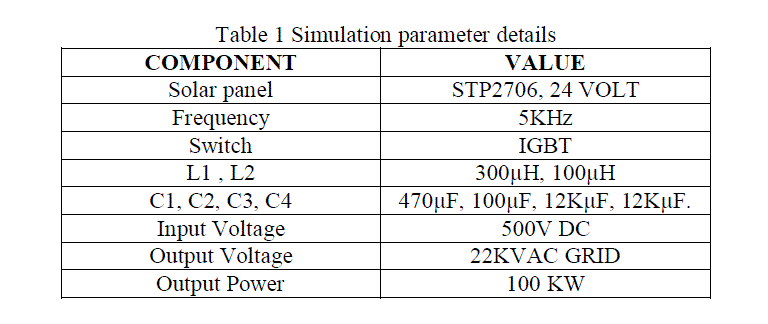 Table 1: Simulation parameter details |
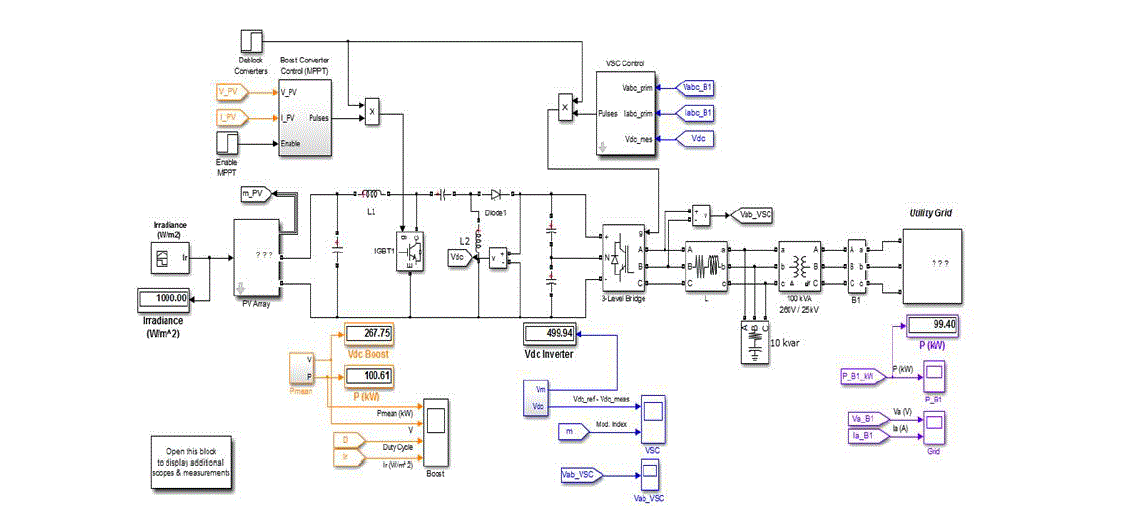 Figure 5:.MATLAB/SIMULINK diagram of grid tie-up inverter using single switch SEPIC converter. |
V.OUTPUT RESULTS AND DISCUSSION |
| The following fig.6 shows the irradiation level on a day the step up response type increasing. And the corresponding performances of the SEPIC converter and the three phase inverter are shown in figures (7) and (8). |
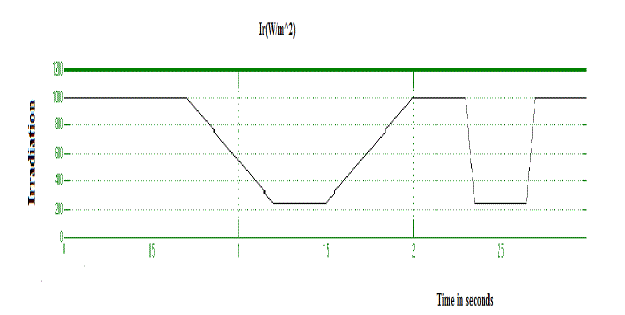 Figure 6: Solar Irradiation Level on a Day |
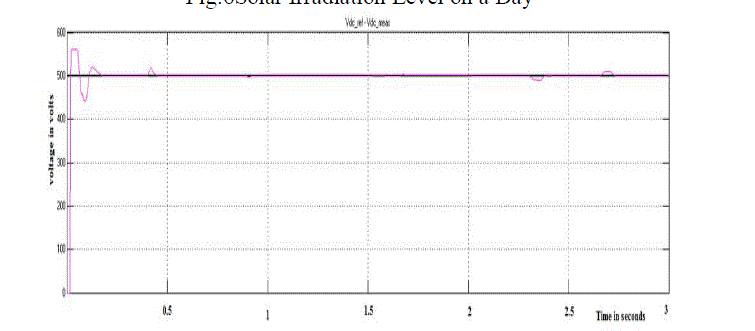 Figure 7: SEPIC Converter Output Voltage |
| The power injected into the grid by the proposed configuration corresponding to the change in the level of irradiation as what specified earlier is shown in fig. (9). |
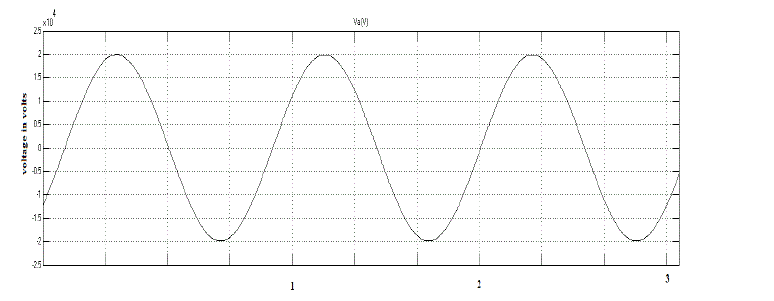 Figure 8: Three Level Inverter Output Voltage |
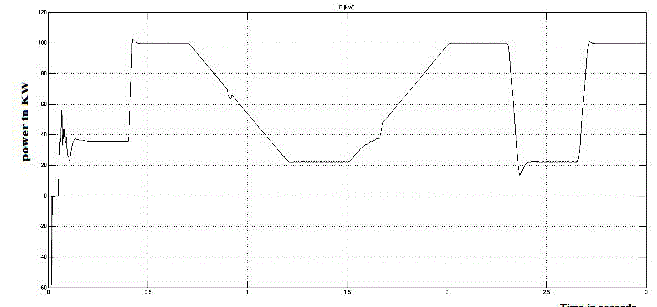 Figure 9: Grid Power Injections and Inverter Output Power. |
| Fig.9 shows the dynamic response of the proposed control with the PV system under different levels of the irradiation. During different operating conditions, the dc bus voltage at the input of the grid interfacing inverter is maintained at constant level as can be seen from the fig. (7), which is the output of the SEPIC converter, hence keeping a good functionality of the proposed system configuration thereby to facilitate the active power flow. |
VI.CONCLUSION |
| Solar irradiance to electrical energy using cascaded approach SEPIC with three wire inverter adopting a nonlinear control technique was able to compensate the unbalanced load, the harmonic currents and the reactive power are achieved as well. A modification to the generating reference currents for the nonlinear control using a positive progression rather than a passive filter that has many drawbacks in terms of dynamics and robustness. Also, it is proposes, a sliding mode type of control for a SEPIC converter in order to improve the efficiency and performance of the maximum power tracking. Today, high step up converters play an important role in the engineering. Applications such as Uninterrupted Power Supplies (UPS), electric traction, fuel cell systems and photovoltaic systems rely on such converters. |
References |
|